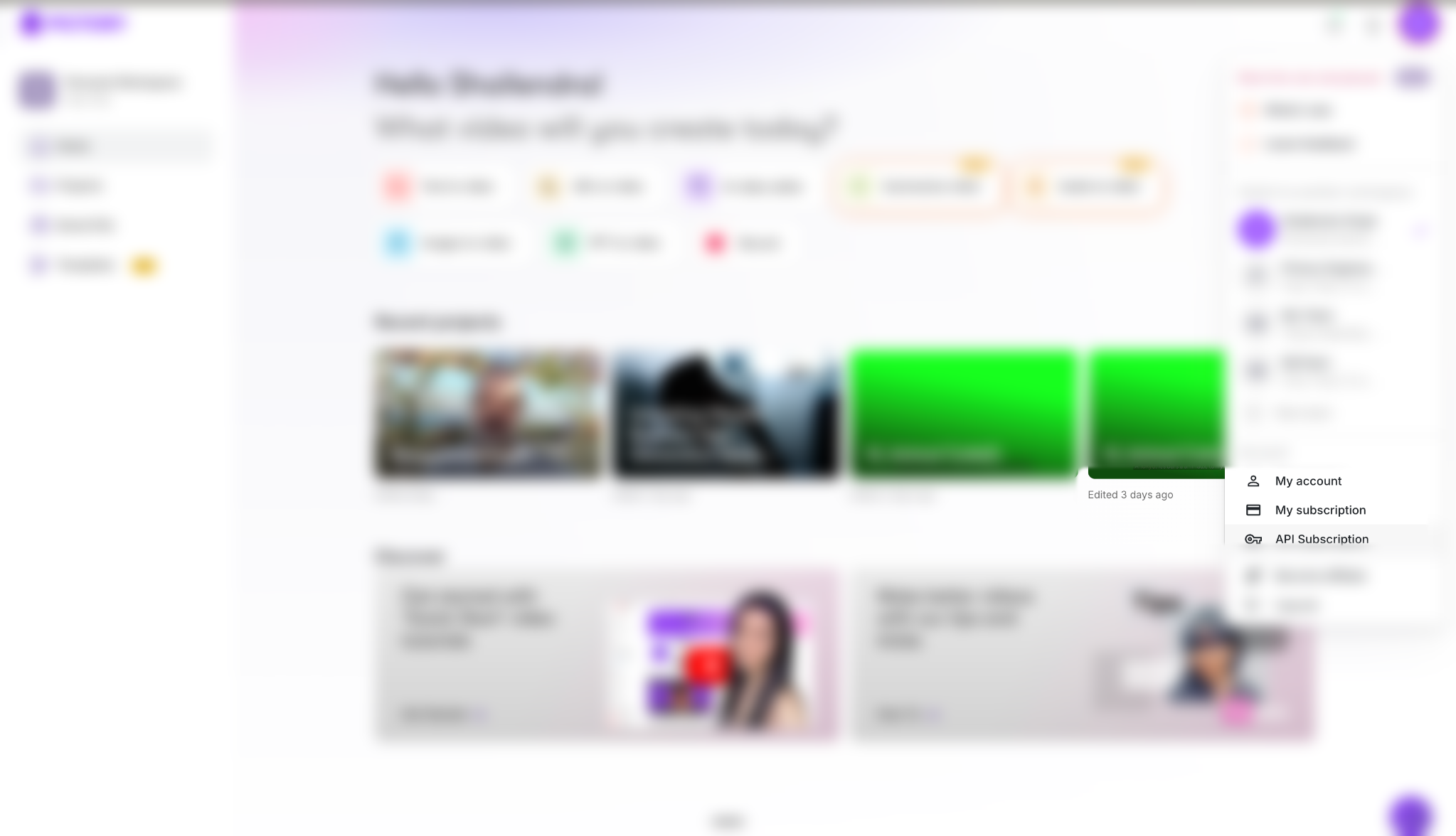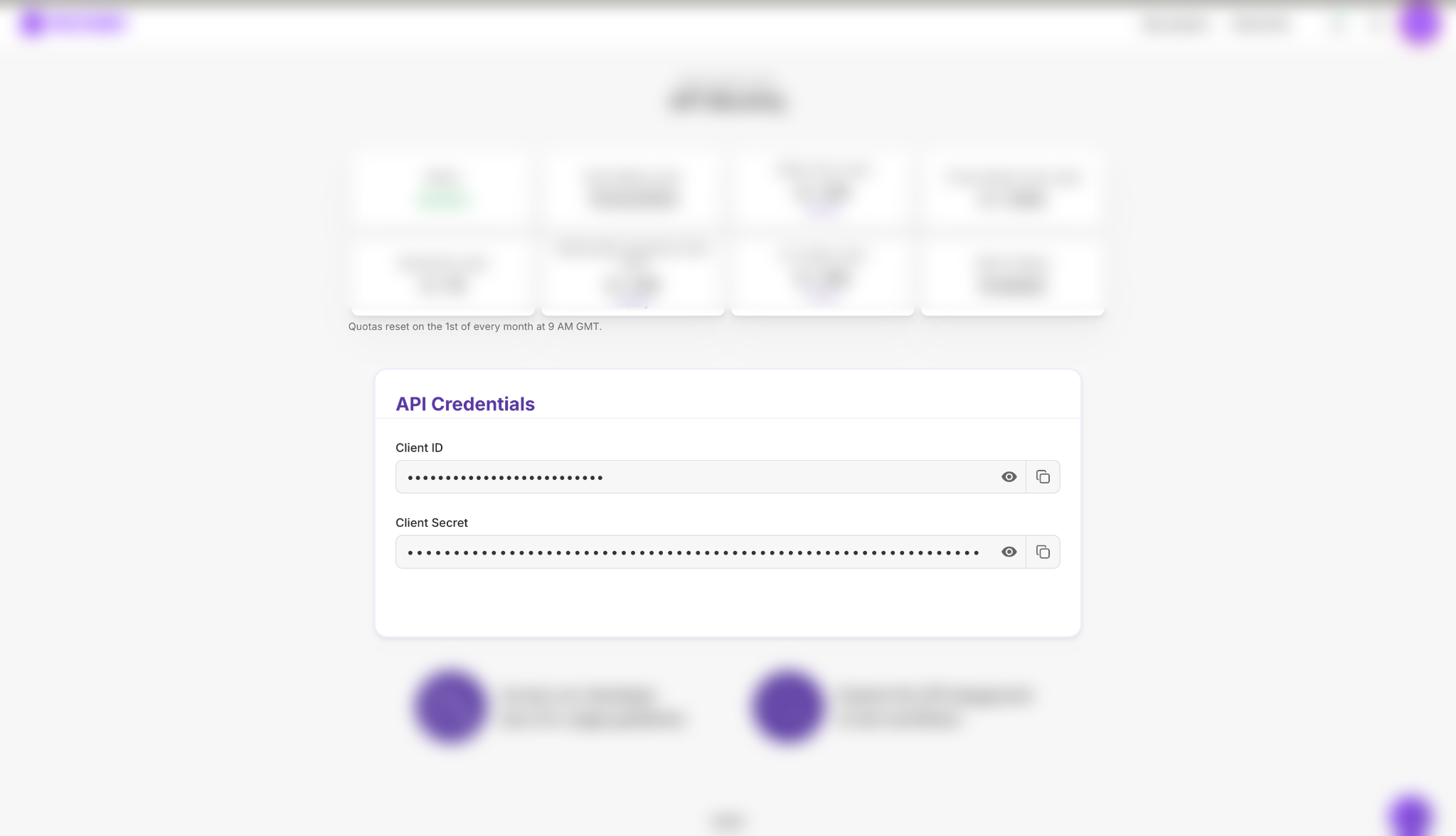Getting Started with Pictory API
Welcome to the Pictory API! This guide will help you get started with creating videos programmatically using our powerful AI-driven video creation platform.
Overview
The Pictory API allows you to:
- Convert text to video with stock visuals or AI-generated visuals
- Transform blog posts into engaging videos
- Create videos from PowerPoint presentations
- Generate video highlights from long-form content
- Add AI voice-overs, subtitles, and branding to your videos
Prerequisites
Before you begin, you'll need:
- A Pictory account
- An active API subscription
- Your API credentials (Client ID and Client Secret)
Step 1: Sign Up and Purchase API Subscription
Create Your Pictory Account
- Visit https://app.pictory.ai and create a free account
- Complete the registration process
Purchase an API Subscription
- Log in to your Pictory account
- Click on your user profile circular button in the top-right corner
- From the dropdown menu, select API Subscription

- Choose a subscription plan that fits your needs
- Complete the purchase process
Step 2: Obtain Your API Credentials
Once you have an active API subscription:
- Navigate to the API Subscription page (if not already there)
- Your API credentials will be displayed on this page

You will need two credentials to use the API:
- Client ID: Your unique client identifier
- Client Secret: Your secret key (keep this secure!)
Important: Keep your Client Secret confidential. Never share it or commit it to version control.
Step 3: Authentication
Before making any API requests, you need to obtain an access token. The access token is used to authenticate all subsequent API calls.
Authentication Endpoint
POST https://api.pictory.ai/pictoryapis/v1/oauth2/tokenNode.js Authentication Example
import axios from 'axios';
const API_BASE_URL = 'https://api.pictory.ai/pictoryapis';
const CLIENT_ID = 'YOUR_CLIENT_ID';
const CLIENT_SECRET = 'YOUR_CLIENT_SECRET';
async function getAccessToken() {
try {
const response = await axios.post(
`${API_BASE_URL}/v1/oauth2/token`,
{
client_id: CLIENT_ID,
client_secret: CLIENT_SECRET
},
{
headers: {
'Content-Type': 'application/json'
}
}
);
const accessToken = response.data.access_token;
const expiresIn = response.data.expires_in;
console.log('Access Token:', accessToken);
console.log('Expires In:', expiresIn, 'seconds');
return accessToken;
} catch (error) {
console.error('Authentication Error:', error.response?.data || error.message);
throw error;
}
}
// Get access token
const token = await getAccessToken();Python Authentication Example
import requests
API_BASE_URL = 'https://api.pictory.ai/pictoryapis'
CLIENT_ID = 'YOUR_CLIENT_ID'
CLIENT_SECRET = 'YOUR_CLIENT_SECRET'
def get_access_token():
try:
response = requests.post(
f'{API_BASE_URL}/v1/oauth2/token',
json={
'client_id': CLIENT_ID,
'client_secret': CLIENT_SECRET
},
headers={
'Content-Type': 'application/json'
}
)
response.raise_for_status()
data = response.json()
access_token = data['access_token']
expires_in = data['expires_in']
print(f'Access Token: {access_token}')
print(f'Expires In: {expires_in} seconds')
return access_token
except requests.exceptions.RequestException as error:
print(f'Authentication Error: {error}')
raise
# Get access token
token = get_access_token()Authentication Response
A successful authentication request returns:
{
"access_token": "eyJhbGciOiJIUzI1NiIsInR5cCI6IkpXVCJ9...",
"token_type": "Bearer",
"expires_in": 3600
}- access_token: Use this token in the
Authorizationheader for all API requests - token_type: Always "Bearer"
- expires_in: Token validity duration in seconds (typically 3600 seconds / 1 hour)
Important: Access tokens expire after the specified duration. You'll need to request a new token when the current one expires.
Step 4: Create Your First Video
Now that you have an access token, let's create your first video from text!
Complete Example: Text to Video
Node.js
import axios from 'axios';
const API_BASE_URL = 'https://api.pictory.ai/pictoryapis';
const CLIENT_ID = 'YOUR_CLIENT_ID';
const CLIENT_SECRET = 'YOUR_CLIENT_SECRET';
async function createTextToVideo() {
try {
// Step 1: Get Access Token
console.log('Step 1: Getting access token...');
const tokenResponse = await axios.post(
`${API_BASE_URL}/v1/oauth2/token`,
{
client_id: CLIENT_ID,
client_secret: CLIENT_SECRET
},
{
headers: {
'Content-Type': 'application/json'
}
}
);
const accessToken = tokenResponse.data.access_token;
console.log('Access token obtained successfully\n');
// Step 2: Create and Render Video
console.log('Step 2: Creating video...');
const videoResponse = await axios.post(
`${API_BASE_URL}/v2/video/storyboard/render`,
{
videoName: 'my_first_video',
scenes: [
{
story: 'Welcome to Pictory API! Create amazing videos with just a few lines of code.',
createSceneOnNewLine: true,
createSceneOnEndOfSentence: true
}
]
},
{
headers: {
'Content-Type': 'application/json',
'Authorization': accessToken
}
}
);
const jobId = videoResponse.data.data.jobId;
console.log('Video job created. Job ID:', jobId, '\n');
// Step 3: Monitor Job Status
console.log('Step 3: Monitoring job status...');
let completed = false;
while (!completed) {
const statusResponse = await axios.get(
`${API_BASE_URL}/v1/jobs/${jobId}`,
{
headers: {
'Authorization': accessToken
}
}
);
const status = statusResponse.data.data.status;
console.log('Status:', status);
if (status === 'completed') {
completed = true;
console.log('\nVideo created successfully!');
console.log('Video URL:', statusResponse.data.data.videoUrl);
return statusResponse.data;
} else if (status === 'failed') {
throw new Error('Video creation failed');
}
// Wait 5 seconds before checking again
await new Promise(resolve => setTimeout(resolve, 5000));
}
} catch (error) {
console.error('Error:', error.response?.data || error.message);
throw error;
}
}
// Run the function
createTextToVideo();Python
import requests
import time
API_BASE_URL = 'https://api.pictory.ai/pictoryapis'
CLIENT_ID = 'YOUR_CLIENT_ID'
CLIENT_SECRET = 'YOUR_CLIENT_SECRET'
def create_text_to_video():
try:
# Step 1: Get Access Token
print('Step 1: Getting access token...')
token_response = requests.post(
f'{API_BASE_URL}/v1/oauth2/token',
json={
'client_id': CLIENT_ID,
'client_secret': CLIENT_SECRET
},
headers={
'Content-Type': 'application/json'
}
)
token_response.raise_for_status()
access_token = token_response.json()['access_token']
print('Access token obtained successfully\n')
# Step 2: Create and Render Video
print('Step 2: Creating video...')
video_response = requests.post(
f'{API_BASE_URL}/v2/video/storyboard/render',
json={
'videoName': 'my_first_video',
'scenes': [
{
'story': 'Welcome to Pictory API! Create amazing videos with just a few lines of code.',
'createSceneOnNewLine': True,
'createSceneOnEndOfSentence': True
}
]
},
headers={
'Content-Type': 'application/json',
'Authorization': access_token
}
)
video_response.raise_for_status()
job_id = video_response.json()['data']['jobId']
print(f'Video job created. Job ID: {job_id}\n')
# Step 3: Monitor Job Status
print('Step 3: Monitoring job status...')
completed = False
while not completed:
status_response = requests.get(
f'{API_BASE_URL}/v1/jobs/{job_id}',
headers={
'Authorization': access_token
}
)
status_response.raise_for_status()
status = status_response.json()['data']['status']
print(f'Status: {status}')
if status == 'completed':
completed = True
print('\nVideo created successfully!')
print(f"Video URL: {status_response.json()['data']['videoUrl']}")
return status_response.json()
elif status == 'failed':
raise Exception('Video creation failed')
# Wait 5 seconds before checking again
time.sleep(5)
except requests.exceptions.RequestException as error:
print(f'Error: {error}')
raise
# Run the function
if __name__ == '__main__':
create_text_to_video()How It Works
- Authentication: First, we get an access token using your Client ID and Secret
- Create Video: We send a request to create a video with your text content
- Get Job ID: The API returns a job ID that tracks your video creation
- Monitor Progress: We poll the job status endpoint until the video is ready
- Get Video: Once completed, we receive the URL to download or view your video
Step 5: Understanding the Workflow
API Request Flow
1. Get Access Token
POST /v1/oauth2/token
↓
2. Create Video Job
POST /v2/video/storyboard/render
↓
3. Receive Job ID
↓
4. Poll Job Status
GET /v1/jobs/{jobId}
↓
5. Get Video URL (when status = completed)Job Statuses
- in-progress: Video is being created
- completed: Video is ready, URL is available
- failed: Video creation failed
Next Steps
Now that you've created your first video, explore more features:
Advanced Features
- Add AI Voice-Over: Give your videos professional narration
- Custom Branding: Add logos, custom fonts, and brand colors
- Background Music: Enhance videos with audio tracks
- Multiple Input Types: Use blog URLs, PowerPoint files, or audio files
- Video Editing: Create highlights from long videos
- Subtitle Customization: Control subtitle styles and positioning
API Reference
For complete API documentation, including all available endpoints, parameters, and response formats, refer to the full API reference documentation.
Best Practices
- Secure Your Credentials: Never expose your Client Secret in client-side code or public repositories
- Token Management: Implement token refresh logic when tokens expire
- Error Handling: Always handle API errors gracefully
- Rate Limiting: Be mindful of API rate limits in your subscription plan
- Job Monitoring: Implement appropriate polling intervals (5-10 seconds recommended)
Updated about 2 months ago
